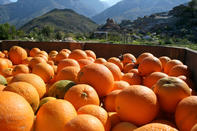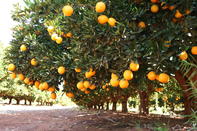Sweet oranges originated in Southeast China and were mentioned in Chinese literature as early as 314 BC. Italian traders and Portuguese navigators spread the fruit species from northeastern India and southeastern China to Mediterranean countries around the 1450s and 1500s.

Oranges were initially only used for medicinal purposes, but soon became a prized fruit reserved for the wealthy.
The orange developed as a hybrid out of mandarin and pummelo. The name ‘orange’ is derived from the Sanskrit word, nāranga, that many believe means ‘fragrant’. The colour orange was named after the fruit and not the other way around.
The word was already in circulation to describe the fruit in the 1300s, whereas the name for the colour only popped up two-hundred years later.
International Production of Oranges
As seen on Tridge, oranges account for 50% of the global citrus production and have been the most cultivated fruit since 1987. Brazil is the biggest producer, it generates nearly 24% of the 73 million tons of oranges produced in 2017. This is followed by China and India which respectively account for 11.5% and 10.3%. South Africa contributes 1.9% of the total orange production.
In a report, called the Global Market Update, the global export value for oranges was estimated at around 6 billion USD and the quantity at 7.3 million tons.
Spain is the biggest exporter, it accounted for almost 25% of all orange exports in 2018. South Africa accounted for 14.5%, Egypt for 12.6% and the United States for almost 12% of the total volume. The United States accounted for 11.8% and the Netherlands for 5.6%.
France, China and Germany were the biggest importers in 2018, with an approximation of 6% to 7% of imports. While the Netherlands and Hong Kong, each accounted for between 6% and 7% of imports.
Production of Oranges in South Africa

Back in the old days, many sailors died of scurvy - an illness that results from an extreme lack of Vitamin C - due to their diets excluding fresh produce.
To address this problem the Dutch East India Company established a refreshment station in Cape Town where traders circling the Cape to trade with India and beyond, could stock up on fresh produce.
The first orange trees were imported from St Helena to South Africa on a boat called, The Tulp, in 1654 with imports from India following soon thereafter. Initially, 1162 orange trees were planted in the Company Gardens in Cape Town along with many other fruit and vegetables. The first oranges were picked in 1661.
New arriving farmers soon began producing oranges from the original stock in the Company Gardens, which resulted in production spreading to different parts of the country.
Today, South Africa is the largest orange exporter in the Southern Hemisphere. It accounts for more than 60% of Southern Hemisphere exports. (Read more about Orange Production in South Africa.)
Uses of Oranges
Oranges may be enjoyed in a variety of ways namely: fresh, juiced, in cooking, in baking, in teas, canned or made into marmalade. This citrus fruit is also used as food and in industrial flavourant, in cleaners as well as facial products.
Oranges are packed with health benefits. It is rich in vitamins, especially A and C, minerals, antioxidants and fibre. While oranges are acidic, they have a lot of alkaline minerals that help to de-alkalise the body and improve digestion.
For bulk or Oranges export enquiries please use the enquiry link below.